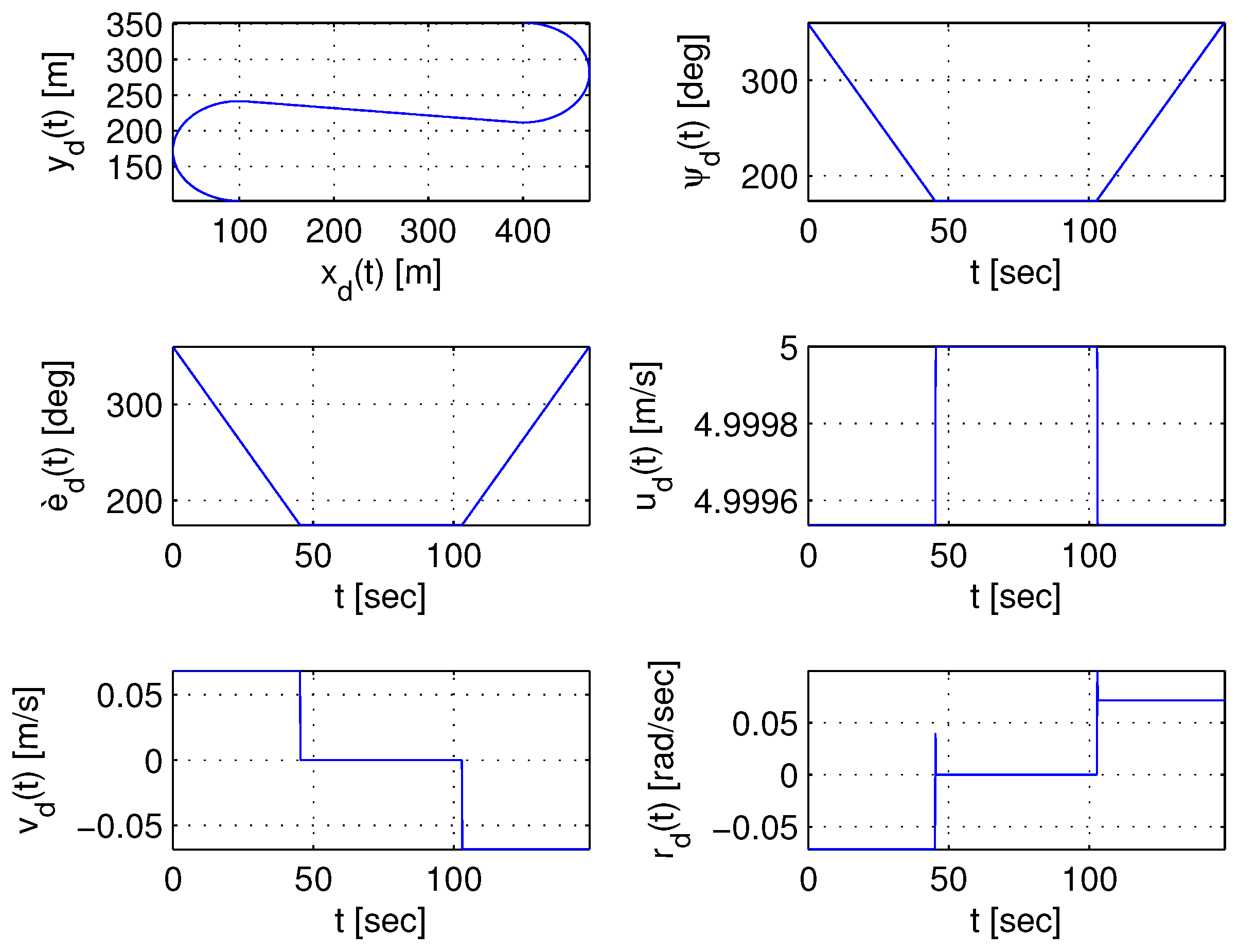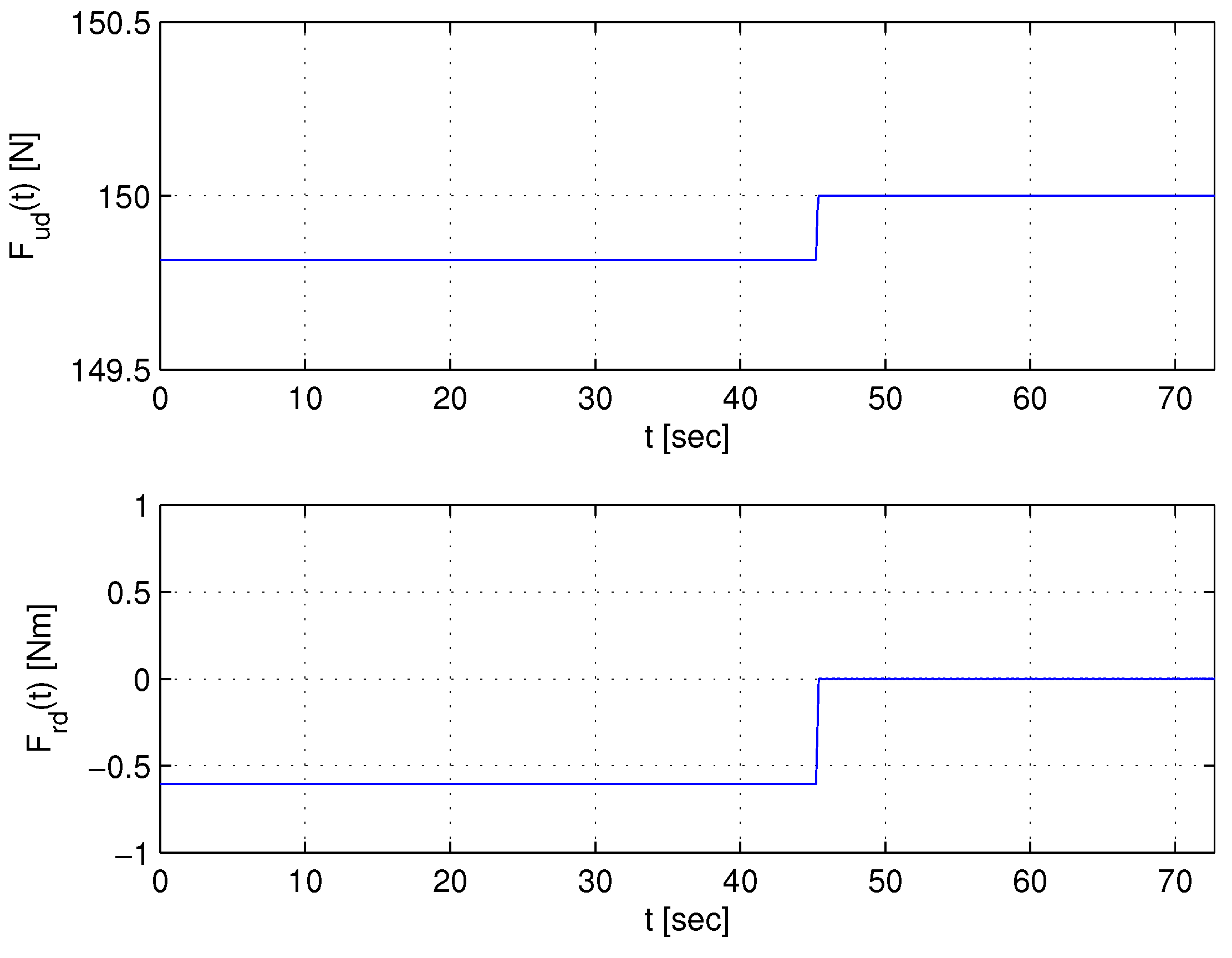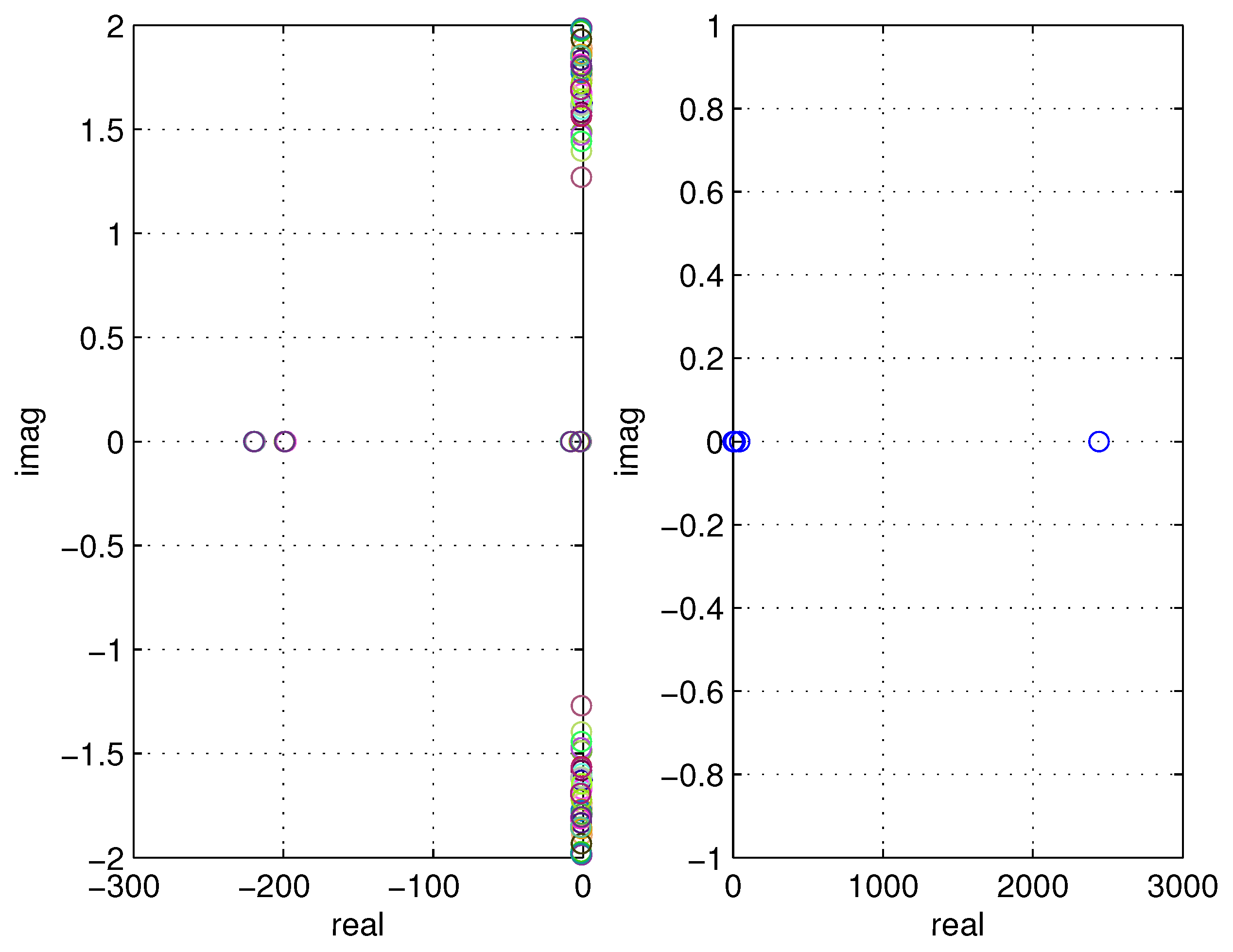Optimal Trajectory Tracking for Underactuated Systems via the Takagi–Sugeno Framework: An Autonomous Underwater Vehicle Mission Case Study
Abstract
1. Introduction
2. Preliminaries
2.1. Notation
2.2. AUV Model
2.3. Generation of the Reference Track—The Dubins Path
2.4. AUV Tracking Problem
2.5. Equivalent TS Model for the Error Dynamics of the AUV
3. Control Law Description and Optimal AUV Tracking
Optimal Tracking
4. Simulation Results
- Choice of the premise vector and calculation of bounds based on the compact region on the state ;
- Definition of the membership functions;
- Determination of all possible model rules r composed of the premise variables and the ranking of the membership function of the premise variable;
- Calculation of the matrices and , for with respect to the bounds on the premise variables;
5. Conclusions
Author Contributions
Funding
Data Availability Statement
Conflicts of Interest
Abbreviations
| AUV | Autonomous Underwater Vehicle |
| TS | Takagi–Sugeno |
| PDC | Parallel Distributed Compensation |
| LMI | Linear Matrix Inequality |
Appendix A
References
- Rogers, A.; Brierley, A.; Croot, P.; Cunha, M.; Danovaro, R.; Devey, C.; Hoel, A.; Ruhl, H.; Sarradin, P.M.; Trevisanut, S.; et al. Delving Deeper: Critical Challenges for 21st Century Deep-Sea Research; Larkin, K.E., Donaldson, K., McDonough, N., Eds.; Position Paper 22; European Marine Board: Ostend, Belgium, 2015. [Google Scholar]
- Sahoo, S.; Choudhury, B.; Dhal, P. Exploring the Role of Robotics in Maritime Technology: Innovations, Challenges, and Future Prospects. Spectr. Mech. Eng. Oper. Res. 2024, 1, 159–176. [Google Scholar] [CrossRef]
- Fossen, T.I. Guidance and Control of Ocean Vehicles; Wiley: New York, NY, USA, 1994. [Google Scholar]
- Do, K.D.; Pan, J. Control of Ships and Underwater Vehicles: Design for Underactuated and Nonlinear Marine Systems; Springer: London, UK, 2009. [Google Scholar]
- Khalil, H.K. Nonlinear Systems, 3rd ed.; Prentice Hall, Inc.: Saddle River, NJ, USA, 2002. [Google Scholar]
- Sordalen, O.; Egeland, O. Exponential stabilization of nonholonomic chained systems. IEEE Trans. Autom. Control 1995, 40, 35–49. [Google Scholar]
- Pettersen, K.; Egeland, O. Exponential stabilization of an underactuated autonomous surface vessel. In Proceedings of the 35th IEEE Conference on Decision and Control, Kobe, Japan, 11–13 December 1996; pp. 967–971. [Google Scholar]
- Murray, R. Control of nonholonomic systems using chained forms. Fields Inst. Commun. 1993, 1, 219–245. [Google Scholar]
- Nakamura, Y.; Savant, S. Nonlinear tracking control of autonomous underwater vehicles. In Proceedings of the 1992 IEEE International Conference on Robotics and Automation, Nice, France, 12–14 May 1992; Volume 3, pp. A4–A9. [Google Scholar]
- Jiang, Z.P. Global tracking control of underactuated ships by Lyapunov’s direct method. Automatica 2002, 38, 301–309. [Google Scholar] [CrossRef]
- Pettersen, K.Y.; Egeland, O. Time-Varying Exponential Stabilization of the Position and Attitude of an Underactuated Autonomous Underwater Vehicle. IEEE Trans. Autom. Control 1999, 44, 112–115. [Google Scholar] [CrossRef]
- Pettersen, K.; Nijmeijer, H. Global practical stabilization and tracking for an underactuated ship-a combined averaging and backstepping approach. In Proceedings of the IFAC Conference on Systems Structure Control, Tampa, FL, USA, 12–19 December 1998; pp. 59–64. [Google Scholar]
- Lefeber, E.; Pettersen, K.; Nijmeijer, H. Tracking Control of an Underactuated Ship. IEEE Trans. Control Syst. Technol. 2003, 11, 52–61. [Google Scholar]
- Li, D.; Du, L. AUV Trajectory Tracking Models and Control Strategies: A Review. J. Mar. Sci. Eng. 2021, 9, 1020. [Google Scholar] [CrossRef]
- Wang, Y.; Du, Z. Trajectory Tracking Control for an Underactuated AUV via Nonsingular Fast Terminal Sliding Mode Approach. J. Mar. Sci. Eng. 2024, 12, 1442. [Google Scholar] [CrossRef]
- Cho, G.; Li, J.; Park, D.; Jung, J. Robust trajectory tracking of autonomous underwater vehicles using back-stepping control and time delay estimation. Ocean Eng. 2020, 201, 107–131. [Google Scholar]
- Elmokadem, T.; Zribi, M.; Youcef-Toumi, K. Trajectory tracking sliding mode control of underactuated AUVs. Nonlinear Dyn. 2016, 86, 1079–1091. [Google Scholar]
- Ma, C.; Jia, J.; Zhang, T.; Wu, S.; Jiang, D. Horizontal trajectory tracking control for underactuated autonomous underwater vehicles based on contraction theory. J. Mar. Sci. Eng. 2023, 11, 805. [Google Scholar] [CrossRef]
- Yang, X.; Yan, J.; Hua, C.; Guan, X. Trajectory tracking control of autonomous underwater vehicle with unknown parameters and external disturbances. IEEE Trans. Syst. Man Cybern. Syst. 2021, 51, 1054–1063. [Google Scholar] [CrossRef]
- Heshmati-Alamdari, S.; Bechlioulis, C.; Karras, G.; Kyriakopoulos, K. Cooperative Impedance Control for Multiple Underwater Vehicle Manipulator Systems Under Lean Communication. IEEE J. Ocean. Eng. 2020, 46, 447–465. [Google Scholar] [CrossRef]
- Godhavn, J.; Fossen, T.; Berge, S. Nonlinear and adaptive backstepping designs for tracking control of ships. Int. J. Adapt. Control Signal Process. 1998, 12, 649–670. [Google Scholar] [CrossRef]
- Liu, L.; Zhang, L.; Pan, G.; Zhang, S. Robust yaw control of autonomous underwater vehicle based on fractional-order PID controller. Ocean Eng. 2022, 257, 111493. [Google Scholar] [CrossRef]
- Olfati-Saber, R. Nonlinear Control of Underactuated Mechanical Systems with Application to Robotics and Aerospace Vehicles. Ph.D. Thesis, Massachusetts Institute of Technology, Cambridge, MA, USA, 2001. [Google Scholar]
- Yang, X.; Li, J. Trajectory tracking control of underactuated AUV in the presence of ocean currents. Int. J. Control Autom. 2016, 9, 81–92. [Google Scholar] [CrossRef]
- Yan, Z.; Zhang, M.; Zhou, J.; Yue, L. Distributed Lyapunov-Based Model Predictive Control for AUV Formation Systems with Multiple Constraints. J. Mar. Sci. Eng. 2024, 12, 363. [Google Scholar] [CrossRef]
- Repoulias, F.; Papadopoulos, E. Trajectory planning and tracking control design of underactuated AUVs. In Proceedings of the IEEE International Conference on Robotics and Automation, ICRA 05, Barcelona, Spain, 18–22 April 2005; pp. 1622–1627. [Google Scholar]
- Repoulias, F.; Papadopoulos, E. Planar trajectory planning and tracking control design for underactuated AUVs. Ocean Eng. 2007, 34, 1650–1667. [Google Scholar] [CrossRef]
- Lapierre, L.; Soetanto, D. Nonlinear Path-following Control of an AUV. Ocean Eng. 2007, 34, 1734–1744. [Google Scholar] [CrossRef]
- Valavanis, K.; Gracanin, D.; Matijasevic, M.; Kolluru, R.; Demetriou, G. Control architectures for autonomous underwater vehicles. IEEE Control Syst. Mag. 1997, 17, 48–64. [Google Scholar]
- Lefeber, E. Tracking Control of Nonlinear Mechanical Systems. Ph.D. Thesis, University of Twente, Enschede, The Netherlands, 2000. [Google Scholar]
- Do, K.D.; Pan, J.; Jiang, Z.P. Global Exponential Tracking Control of Underactuated Surface Ships in the Body Frame. In Proceedings of the American Control Conference, Anchorage, AK, USA, 8–10 May 2000; pp. 4702–4707. [Google Scholar]
- Do, K.D.; Jiang, Z.P.; Pan, J. Underactuated Ship Global Tracking under Relaxed Conditions. IEEE Trans. Autom. Control 2000, 47, 1529–1536. [Google Scholar] [CrossRef]
- Brockett, R.W. Asymptotic stability and feedback stabilization. In Differential Geometric Control Theory; Millman, R.S., Brockett, R.W., Sussmann, H.J., Eds.; Birkauser: Basel, Switzerland, 1983. [Google Scholar]
- Soltan, R.; Ashrafiuon, H.; Muske, K. State-dependent trajectory planning and tracking control of unmanned surface vessels. In Proceedings of the American Control Conference, St. Louis, MO, USA, 10–12 June 2009; IEEE: Piscataway, NJ, USA, 2009; pp. 3597–3602. [Google Scholar]
- Ma, B.; Xie, W. Global asymptotic trajectory tracking and point stabilization of asymmetric underactuated ships with non-diagonal inertia/damping matrices. Int. J. Adv. Robot. Syst. 2013, 10, 336. [Google Scholar]
- Harmouche, M.; Laghrouche, S.; Chitour, Y. Global tracking for underactuated ships with bounded feedback controllers. Int. J. Control 2014, 87, 2035–2043. [Google Scholar] [CrossRef][Green Version]
- Liao, Y.; Su, Y.; Cao, J. Trajectory planning and tracking control for underactuated unmanned surface vessels. J. Cent. South Univ. 2014, 21, 540–549. [Google Scholar]
- Dong, Z.; Wan, L.; Li, Y.; Liu, T.; Zhang, G. Trajectory tracking control of underactuated USV based on modified backstepping approach. Int. J. Nav. Archit. Ocean Eng. 2015, 7, 817–832. [Google Scholar] [CrossRef]
- Tanaka, K.; Wang, H.O. Fuzzy Control Systems Design and Analysis: A Linear Matrix Inequality Approach; John Wiley and Sons, Inc.: New York, NY, USA, 2001. [Google Scholar]
- Chang, M.; Chang, W.; H Liu, H. Model-based fuzzy modeling and control for autonomous underwater vehicles in the horizontal plane. J. Mar. Sci. Technol. 2003, 11, 155–163. [Google Scholar] [CrossRef]
- Jun, S.; Kim, D.; Lee, H. Design of TS fuzzy model-based controller for depth control of autonomous underwater vehicles with parametric uncertainties. In Proceedings of the 11th International Conference of Control, Automation and Systems (ICCAS), Gyeonggi-do, Republic of Korea, 26–29 October 2011; pp. 1682–1684. [Google Scholar]
- Wang, H.O.; Tanaka, K.; Griffin, M.F. Parallel Distributed Compensation of Nonlinear Systems by Takagi-Sugeno Fuzzy Model. In Proceedings of the 1995 IEEE International Conference on Fuzzy Systems, Yokohama, Japan, 20–24 March 1995; pp. 531–538. [Google Scholar]
- Kladis, G.P.; Menon, P.P.; Edwards, C. Cooperative tracking for a swarm of Unmanned Aerial Vehicles: A distributed Tagaki-Sugeno fuzzy framework design. In Proceedings of the 50th IEEE Conference on Decision and Control and European Control Conference (CDC-ECC), Orlando, FL, USA, 12–15 December 2011; pp. 4114–4119. [Google Scholar]
- Shanmugavel, M. Path Planning of Multiple Autonomous Vehicles. Ph.D. Thesis, Cranfield University, Wharley End, UK, 2007. [Google Scholar]
- Tanaka, K.; Wang, H.O. Fuzzy Regulators and Fuzzy Observers: A Linear Matrix Inequality Approach. In Proceedings of the 36th IEEE Conference on Decision and Control, San Diego, CA, USA, 12 December 1997; Volume 2, pp. 1315–1320. [Google Scholar]
- Tanaka, K.; Ikeda, T.; Wang, H.O. Fuzzy Regulators and Fuzzy Observers. IEEE Trans. Fuzzy Syst. 1998, 6, 250–265. [Google Scholar] [CrossRef]
- Delmotte, F.; Lauber, J.; Guerra, T.M. A multi-model controller. In Proceedings of the 2008 IEEE International Conference on Fuzzy Systems (IEEE World Congress on Computational Intelligence), Hong Kong, China, 1–6 June 2008; pp. 1524–1529. [Google Scholar]
- Guerra, T.M.; Kruszewski, A.; Vermeiren, L.; Tirmant, H. Conditions of output stabilization for nonlinear models in the Takagi–Sugeno form. Fuzzy Sets Syst. 2006, 157, 1248–1259. [Google Scholar] [CrossRef]
- Bernal, M.; Sala, A.; Lendek, Z.; Guerra, T.M. Analysis and Synthesis of Nonlinear Control Systems; Springer: Berlin/Heidelberg, Germany, 2022. [Google Scholar]
- Sahingoz, O. Generation of bezier curve-based flyable trajectories for multi-uav systems with parallel genetic algorithm. J. Intell. Robot. Syst. 2014, 74, 499–511. [Google Scholar] [CrossRef]
- Shivgan, R.; Dong, Z. Energy-efficient drone coverage path planning using genetic algorithm. In Proceedings of the 2020 IEEE 21st International Conference on High Performance Switching and Routing (HPSR), Newark, NJ, USA, 11–14 May 2020; pp. 1–6. [Google Scholar]
- Ntakolia, C.; Kladis, G.P.; Lyridis, D. A fuzzy logic approach of pareto optimality for multi-objective path planning in case of unmanned surface vehicle. J. Intell. Robot. Syst. 2023, 109, 21. [Google Scholar] [CrossRef]
- Zeng, Z.; Sammut, K.; Lian, L.; He, F.; Lammas, A.; Tang, Y. A comparison of optimization techniques for AUV path planning in environments with ocean currents. Robot. Auton. Syst. 2016, 82, 61–82. [Google Scholar] [CrossRef]
- Nikolos, I.; Tsourveloudis, N. Path planning for cooperating unmanned vehicles over 3-D terrain. Inf. Control Autom. Robot. 2009, 24, 153–168. [Google Scholar]
- Kladis, G.P.; Economou, J.T.; Lauber, J.; Guerra, T.M. Energy Conservation Based Fuzzy Tracking For Unmanned Aerial Vehicle Missions Under Priori Known Wind Information. Eng. Appl. Artif. Intell. 2011, 24, 278–294. [Google Scholar]
- Kawamoto, S.; Tada, K.; Ishigame, A.; Taniguchi, T. An Approach to Stability Analysis of Second Order Fuzzy Systems. In Proceedings of the First IEEE International Conference on Fuzzy Systems, San Diego, CA, USA, 8–12 March 1992; Volume 1, pp. 1427–1434. [Google Scholar]
- Liu, X.; Zhang, Q. New approaches to controller designs based on fuzzy observers for Takagi–Sugeno fuzzy systems via LMI. Automatica 2003, 39, 1571–1582. [Google Scholar]
- Qiu, J.; Feng, G.; Gao, H. Observer-based piecewise affine output feedback controller synthesis of continuous-time T-S fuzzy affine dynamic systems using quantized measurements. IEEE Trans. Fuzzy Syst. 2012, 20, 1046–1062. [Google Scholar]
- Qiu, J.; Feng, G.; Gao, H. Fuzzy-model-based piecewise Hinf static-output-feedback controller design for networked nonlinear systems. IEEE Trans. Fuzzy Syst. 2010, 18, 919–934. [Google Scholar]
- Kladis, G.; Menon, P.; Edwards, C. Fuzzy distributed cooperative tracking for a swarm of unmanned aerial vehicles with heterogeneous goals. Int. J. Syst. Sci. 2015, 47, 3803–3811. [Google Scholar]
- Lofberg, J. YALMIP: A toolbox for modeling and optimization in MATLAB. In Proceedings of the 2004 IEEE International Conference on Robotics and Automation, Taipei, Taiwan, 2–4 September 2004; pp. 284–289. [Google Scholar]
- Lendek, Z.; Lauber, J.; Guerra, T.M.; Babuska, R.; De Schuttera, B. Adaptive observers for TS fuzzy systems with unknown polynomial inputs. Fuzzy Sets Syst. 2010, 161, 2043–2065. [Google Scholar]










Disclaimer/Publisher’s Note: The statements, opinions and data contained in all publications are solely those of the individual author(s) and contributor(s) and not of MDPI and/or the editor(s). MDPI and/or the editor(s) disclaim responsibility for any injury to people or property resulting from any ideas, methods, instructions or products referred to in the content. |
© 2025 by the authors. Licensee MDPI, Basel, Switzerland. This article is an open access article distributed under the terms and conditions of the Creative Commons Attribution (CC BY) license (https://creativecommons.org/licenses/by/4.0/).
Share and Cite
Kladis, G.P.; Doitsidis, L.; Tsourveloudis, N.C. Optimal Trajectory Tracking for Underactuated Systems via the Takagi–Sugeno Framework: An Autonomous Underwater Vehicle Mission Case Study. Robotics 2025, 14, 45. https://doi.org/10.3390/robotics14040045
Kladis GP, Doitsidis L, Tsourveloudis NC. Optimal Trajectory Tracking for Underactuated Systems via the Takagi–Sugeno Framework: An Autonomous Underwater Vehicle Mission Case Study. Robotics. 2025; 14(4):45. https://doi.org/10.3390/robotics14040045
Chicago/Turabian StyleKladis, Georgios P., Lefteris Doitsidis, and Nikos C. Tsourveloudis. 2025. "Optimal Trajectory Tracking for Underactuated Systems via the Takagi–Sugeno Framework: An Autonomous Underwater Vehicle Mission Case Study" Robotics 14, no. 4: 45. https://doi.org/10.3390/robotics14040045
APA StyleKladis, G. P., Doitsidis, L., & Tsourveloudis, N. C. (2025). Optimal Trajectory Tracking for Underactuated Systems via the Takagi–Sugeno Framework: An Autonomous Underwater Vehicle Mission Case Study. Robotics, 14(4), 45. https://doi.org/10.3390/robotics14040045





